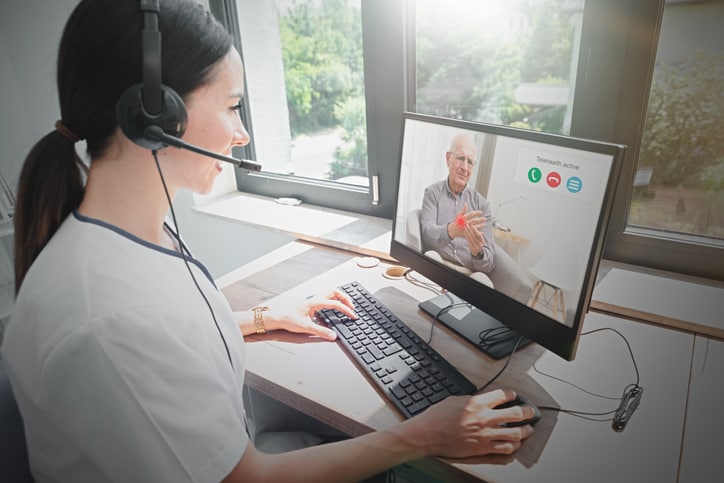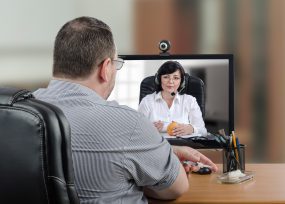DSMES Settings

DSMES as emergency medicine, provided via telehealth.
In the past, DSMES services typically provided information to people with diabetes in an instructional manner and setting. However, DSMES services have been evolving into empowerment models21 that help people with diabetes more effectively self-manage their diabetes.22
This more person-centered approach supports sustainable lifestyle changes. More interactive approaches are also associated with better outcomes.23 The trend toward self-management will likely continue as health care resources become scarcer and technology enables more individual engagement and more personalized self-management plans.24 As a result, DSMES services can occur in a variety of settings.
Traditional DSMES settings include:25
- Hospital outpatient departments.
- Independent clinics (freestanding Federally Qualified Health Centers and independent rural health clinics).
- Pharmacies.
- Patient-centered medical homes.26
- Provider practices.
- Public health departments.
- Safety net organizations.
- Home health agencies.
- Skilled nursing homes.
Promoting DSMES in alternative settings can help increase access. Alternative settings include:26,27
- Community-based organizations.
- Community centers.
- Faith-based organizations.
- YMCAs.
- Area Agencies on Aging.
- Durable medical equipment companies.
- Telehealth.
- The home of the person with diabetes.
- Assisted living facilities.
- Worksites.
For Medicare reimbursement, DSMES cannot be provided in certain settings, such as:25
- Inpatient hospital settings.
- End-stage kidney disease (dialysis) facilities.
DSMES Provided in Pharmacies
Pharmacists may serve as part of the multidisciplinary DSMES team (see Standard 3), or they may provide DSMES services directly.
Pharmacists may not directly bill the Centers for Medicare & Medicaid Services (CMS) for diabetes self-management training (DSMT). However, if a pharmacist is employed by a pharmacy that is a Medicare Part B provider and provides services such as urgent care and influenza vaccines, the pharmacy may be able to bill CMS for DSMT services.
Resources
Pharmacists interested in DSMES accreditation can view the webinar “Diabetes Self-Management Education Training” from the Georgia Department of Health as an example of innovation in DSMES services.
DSMES Provided in Shared Medical Appointments
With shared medical appointments (SMAs), groups of patients meet over time for comprehensive care related to a chronic condition or health care state. SMAs usually involve both a person trained or skilled in delivering patient education and a provider who can prescribe medicine. SMA sessions typically last 1 to 2 hours, with time set aside for social integration, interactive education, and medication management to achieve improved disease outcomes.28
SMAs enable providers to offer individual medical appointments in a group setting. They also allow an instructor to provide lifestyle behavior change education (e.g., DSMES, medical nutrition therapy) for people with diabetes after the provider completes the evaluation and management visit.29
SMAs can enhance learning, behavior change, clinical outcomes, quality of life, and cost savings. SMAs can also increase satisfaction for people with diabetes. They may feel more comfortable in a setting where they can actively participate in their own care, learn from each other, support each other, and have more time with providers during the medical visit. Providers and educators can further support people with diabetes by encouraging them to invite their spouses, partners, family members, or caregivers to the SMA.
For additional information on SMAs, see the following resources:
Shared Medical Appointments Tip Sheet
DSMES Provided via Telehealth
Telehealth has emerged as a useful, appropriate, and acceptable DSMES delivery mode for both people with diabetes and providers.
Telehealth is an umbrella term that can mean audio and visual communication in real time. Some payers may reimburse for email, telephone, or online communication (without a visual component). However, for Medicare reimbursement of DSMT, telehealth services must include audio and visual communication in real time.
In practical terms, telehealth services use a real-time audiovisual telecommunication system as a substitute for an in-person encounter between a person with diabetes and a provider located at a different site.31 Delivery of DSMES via telehealth has many benefits:31,32,33
- It is scalable.
- It is reimbursable (see Reimbursement for more information).
- It reaches more people with diabetes in less time.
- It provides an affordable way to effectively and efficiently reach underserved populations.
- It can increase access by addressing barriers such as transportation and area-specific provider shortages.
- It can be easy to engage some people with diabetes with a smartphone, app, or other technology.
- It may require less staff time for follow-up.
- It can bridge the gap between in-person visits.

Barriers to delivering DSMES via telehealth include:31
- Not all technology is appropriate for all people with diabetes. It is important to match technology to each person’s age, abilities, and sensitivities.
- Telehealth may require expensive technology that a provider or setting cannot afford.
- People with diabetes may not have access to the technology.
- Telehealth may require additional training for diabetes care and education specialists.